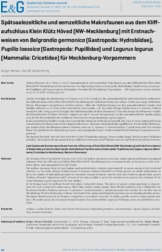Spätsaalezeitliche und eemzeitliche Makrofaunen aus dem Kliffaufschluss Klein Klütz Höved (NW-Mecklenburg)
Menzel-Harloff, Holger; Meng, Stefan, 2015: Spätsaalezeitliche und eemzeitliche Makrofaunen aus dem Kliffaufschluss Klein Klütz Höved (NW-Mecklenburg). In: E&G – Quaternary Science Journal; Vol.64, No.2, p.82-94, DOI: 10.3285/eg.64.2.03.
 |
Dokument öffnen: |
On the basis of the work done by Strahl et al. (1994), the mollusc specimens in the Late Saalian glacial and Eemian interglacial sediments from the cliff outcrop of Klein Klütz Höved (NW Mecklenburg) were re-examined and, in the process, a few vertebrates (fishes, micromammals) were also found.
The mollusc specimens from the Late Saalian sand and mud alone comprise approximately 40 species among which terrestrial varieties, e.g. Succinella oblonga, Pupilla loessica, P. pratensis, Vallonia tenuilabris or Vertigo genesii, are clearly predominant as far as the number of individual specimens is concerned. Among the limnic varieties were also found the glacial index species Pisidium obtusale f. lapponicum and P. stewarti. It was also possible to prove the northern-most presence for Germany of the steppe lemming Lagurus lagurus in the Late Saalian.
In the Eemian mud, the molluscs found were almost exclusively limnic. This about 20 species comprising fauna is characte-ristic of a river system with calmer areas, oxbow lakes and in-coming springs. These fluvial conditions were confirmed by the freshwater bivalves Pisidium amnicum, P. supinum, P. moitessierianum, P. ponderosum and Unio tumidus. For the first time in Mecklenburg-Western Pomerania, evidence was found of the spring snail Belgrandia germanica as an interglacial index species.
The limnic-fluvial section of the Eemian is topped by a cryoturbate structures. Its sandy, gravelly pockets contain marine molluscs. The index species for the marine Eemian found in the southern Baltic region are Polititapes senescens and Bittium reticulatum.

